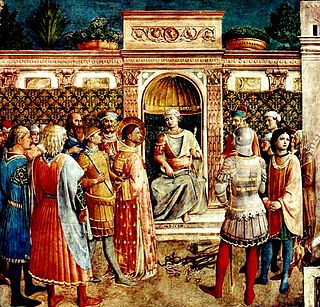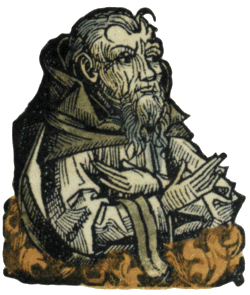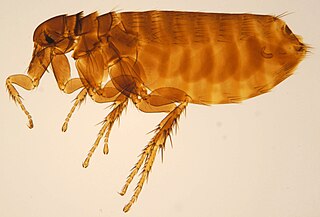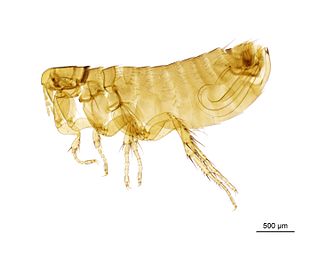Saint Rusticus of Narbonne was a monk of the Lérins Abbey and bishop of Narbonne and Catholic saint of Gaul, born either at Marseilles or at Narbonne.

Saints Firmus and Rusticus are venerated as two martyrs of Verona. Their unreliable Acts state that Firmus and Rusticus, kinsmen, were prominent citizens of Bergamo. They were martyred at Verona under the Emperor Maximian after refusing to sacrifice to pagan idols. Under the judge Anolinus, they were tortured, beaten with clubs, and beheaded.

The rusty crayfish is a large, aggressive species of freshwater crayfish which is native to the United States, in the Ohio River Basin in parts of Ohio, Kentucky, and Indiana. Its range is rapidly expanding across much of eastern North America, displacing native crayfishes in the process. The rusty crayfish was first captured in Illinois in 1973, and has been collected at over 20 locations in the northern portion of the state. In 2005, F. rusticus was found for the first time west of the Continental Divide, in the John Day River, Oregon, which runs into the Columbia River.
Fabius Rusticus was a Roman historian who was quoted on several occasions by Tacitus. Tacitus couples his name with that of Livy and describes him as "the most graphic among ancient and modern historians." Tacitus also said that he embellished matters with his eloquence. Fabius Rusticus is described by Tacitus as a close friend of Seneca who was inclined to praise him in his work.
The rusty pipistrelle is a species of vesper bat. It is found in Angola, Botswana, Burkina Faso, Central African Republic, Chad, Ethiopia, Ghana, Kenya, Malawi, Mozambique, Namibia, Nigeria, Senegal, South Africa, Sudan, Tanzania, Uganda, Zambia, and Zimbabwe. Its natural habitats are dry and moist savanna. It is of note as perhaps Africa's smallest bat, at average weight of 3.5 g (0.12 oz).
Saint Rusticus, the successor of Saint Lupicinus of Lyon (491-494), served as Archbishop of Lyon from 494 to April 501. Later canonized, his feast day is 25 April.

Quintus Junius Rusticus, was a Roman teacher and politician. He was probably a grandson of Arulenus Rusticus, a prominent member of the Stoic Opposition. He was a Stoic philosopher and was one of the teachers of the emperor Marcus Aurelius, whom Aurelius treated with the utmost respect and honour.

Saint Goar of Aquitaine was a priest and hermit of the seventh century. He was offered the position of Bishop of Trier, but prayed to be excused from the position. Goar is noted for his piety and is revered as a miracle-worker. He is a patron saint of innkeepers, potters, and vine growers.
Quintus Junius Arulenus Rusticus was a Roman Senator and a friend and follower of Thrasea Paetus, and like him an ardent admirer of Stoic philosophy. Arulenus Rusticus attained a suffect consulship in the nundinium of September to December 92 with Gaius Julius Silanus as his colleague. He was one of a group of Stoics who opposed the perceived tyranny and autocratic tendencies of certain emperors, known today as the Stoic Opposition.

Saint-Rustice is a commune in the Haute-Garonne department in southwestern France.

Isopogon ceratophyllus, commonly known as the horny cone-bush or wild Irishman, is a plant of the family Proteaceae that is endemic to the coast in Victoria, South Australia and on the Furneaux Group of islands in Tasmania. It is a small woody shrub that grows to 100 cm high with prickly foliage. It is extremely sensitive to dieback from the pathogen Phytophthora cinnamomi

Ceratophyllus gallinae, known as the hen flea in Europe or the European chicken flea elsewhere, is an ectoparasite of birds. This flea was first described by the German botanist and entomologist Franz von Paula Schrank in 1803.

Ceratophyllus is a widespread genus of fleas found in temperate climates. Some of its members include the chicken flea, Ceratophyllus gallinae, and the poultry flea, Ceratophyllus niger.
Ceratophyllus breviprojectus is a species of flea in the family Ceratophyllidae. It was described by Liu, Wu and Wu in 1966.

Ceratophyllus columbae is a species of flea in the family Ceratophyllidae. It was described by Gervais in 1844.
Ceratophyllus phrillinae is a species of flea in the family Ceratophyllidae. It was described by Smit in 1976.

Ceratophyllus garei, the duck flea, is a species of flea in the family Ceratophyllidae. It was described by Rothschild in 1902.
Lucius Antistius Rusticus was a Roman senator active in the later part of the first century AD. He was suffect consul for March to April 90, with Lucius Julius Ursus Servianus as his colleague.
Stygnocoris rusticus is a species of dirt-colored seed bug in the family Rhyparochromidae. It is found in Africa, Europe and Northern Asia, and North America.
Urozelotes rusticus is a species of ground spider found in both Americas, Africa, Europe, Asia, Australia. Its native area is unknown, but it is most likely Old World.









